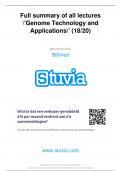Summary
Summary All exercises/self study assigments and solutions from Genome Technology and Applications (19/20)
- Course
- Institution
All exercises/self study assigments and solutions from Genome Technology and Applications (19/20): This document includes all questions AND FULL answers to the exercises of the exercise session of Genome Technology and Applications. It has the answers given by professor Guy van Camp and is thus ver...
[Show more]



